This step by step woodworking project is about how to build a 16×12 pavilion – diy plans. Building a 16×12 pavilion is going to be tremendous for your outdoor space. This guide will show you the best way to get it done, step by step, with the finest details from setting posts to finishing touches, making your pavilion the best it can be. This structure is heavy duty, but please follow the building codes and make modifications, if necessary. See all my the gazebo plans HERE.
We recommend you to invest in the best materials you could afford. Therefore, you should buy weather-resistant lumber, such as pressure-treated lumber, cedar or redwood. If you use regular pine, I recommend you to apply the appropriate products to enhance its durability. Always take accurate measurements before adjusting the size of the components at the proper size. Drill pilot holes trough the components before inserting the wood screws, to prevent the wood from splitting. See all my Premium Plans HERE.
Made from this plan
16×12 Gable Gazebo – DIY Plans
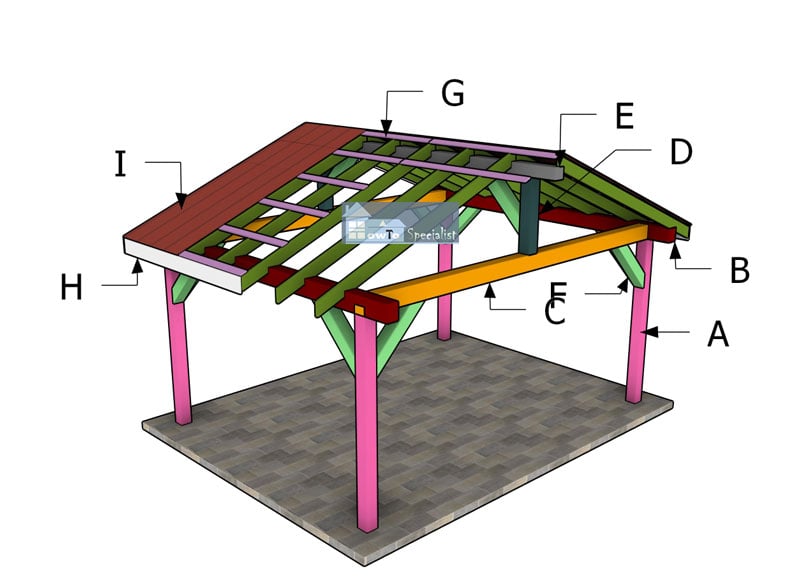
Building-a-16×12-gable-pavilion
Materials
A – Posts – 6×6 lumber 88″ – 4 pieces
B – Side plates – 6×8 lumber 168″ – 2 pieces
C – Top plates – 6×8 lumber 192″ – 2 pieces
D – Supports – 6×6 lumber 33 3/8″ – 2 pieces
E – Ridge Beam – 6×6 lumber 168″ – 1 pieces
F – Braces – 6×6 lumber 36″ – 10 pieces
G – Rafters – 2×6 lumber 120″ – 16 pieces
H – Trims – 1×8 lumber 121 1/2″ – 4 pieces
H – Trims – 1×8 lumber 96″ – 2 pieces
H – Trims – 1×8 lumber 72″ – 2 pieces
I – Purlins – 1×4 lumber 96″ – 12 pieces
I – Purlins – 1×4 lumber 72″ – 12 pieces
*Buy Premium Plans for Cut and Shopping Lists
Tools
- Safety gloves, glasses
- Miter saw, jigsaw
- Chalk line, tape measure, spirit level, carpentry pencil
- Drill machinery and drill bits
Time
- One Week
How to build a 16×12 pavilion – PDF Download
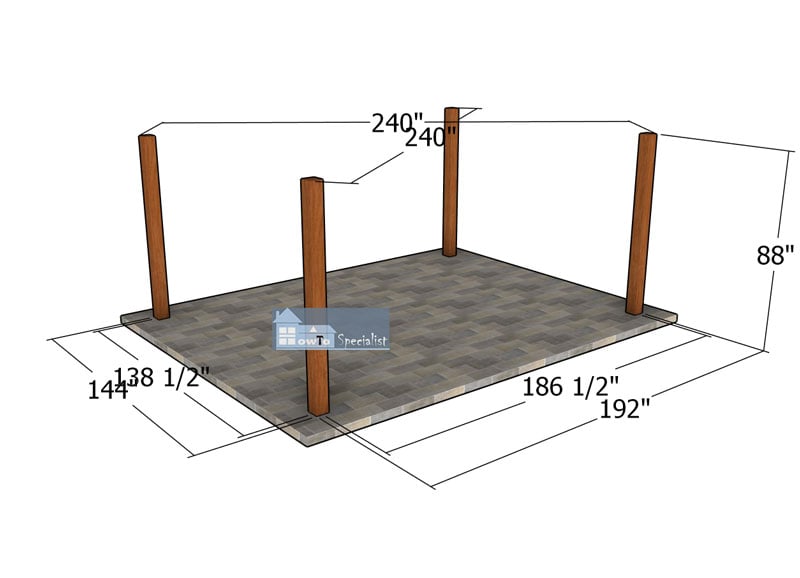
Laying-out-the-gable-pavilion
Alright, you want to layout the posts for the pavilion. First, measure and stake the corners. Run string lines to outline the perimeter and make sure it’s square by checking the diagonals—yeah, math. Mark the post locations, spacing them evenly and aligning them as per the design plan.
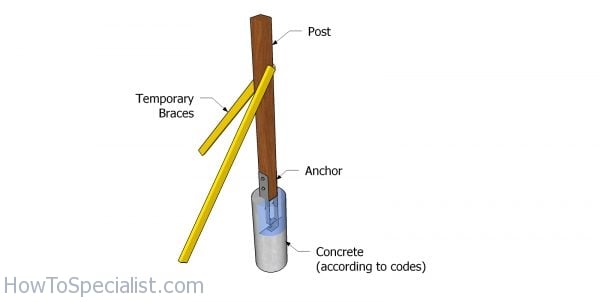
Setting the posts
After marking the location of the posts, you need to dig 3′ deep holes in the ground and 14-16″ in diameter, using a post hole digger. Install tube forms and fill them with concrete. Secure the anchors. For this project we will use post anchors, so you don’t need to set the posts into concrete.
After installing the posts you need to check the tops are aligned one with another. Use a laser level / water level to mark the horizontal line to the top of the posts. Use a circular saw to make the cuts if necessarily. In addition, you can adjust the height of the posts to suit your needs. Therefore, you can cut 1 ft from the 8 ft posts without any consequences; it is just a matter of taste if you want to have the clearance shorter.

Top-plates
Use 6×8 lumber for the top plates, because we have large openings to the front and sides of the pavilion. The 6x8s will make a really sturdy framing and the structure will not bow. Use a saw to create the half lap joints at each end, ensuring precise cuts for a snug fit. Set the saw depth at 3 5/8″.
Make parallel cuts and then remove the excess with a hammer and a chisel. Smooth the recesses with sandpaper. These cut outs will help you create half lap joints, which makes for a strong and durable way of bonding wood together.
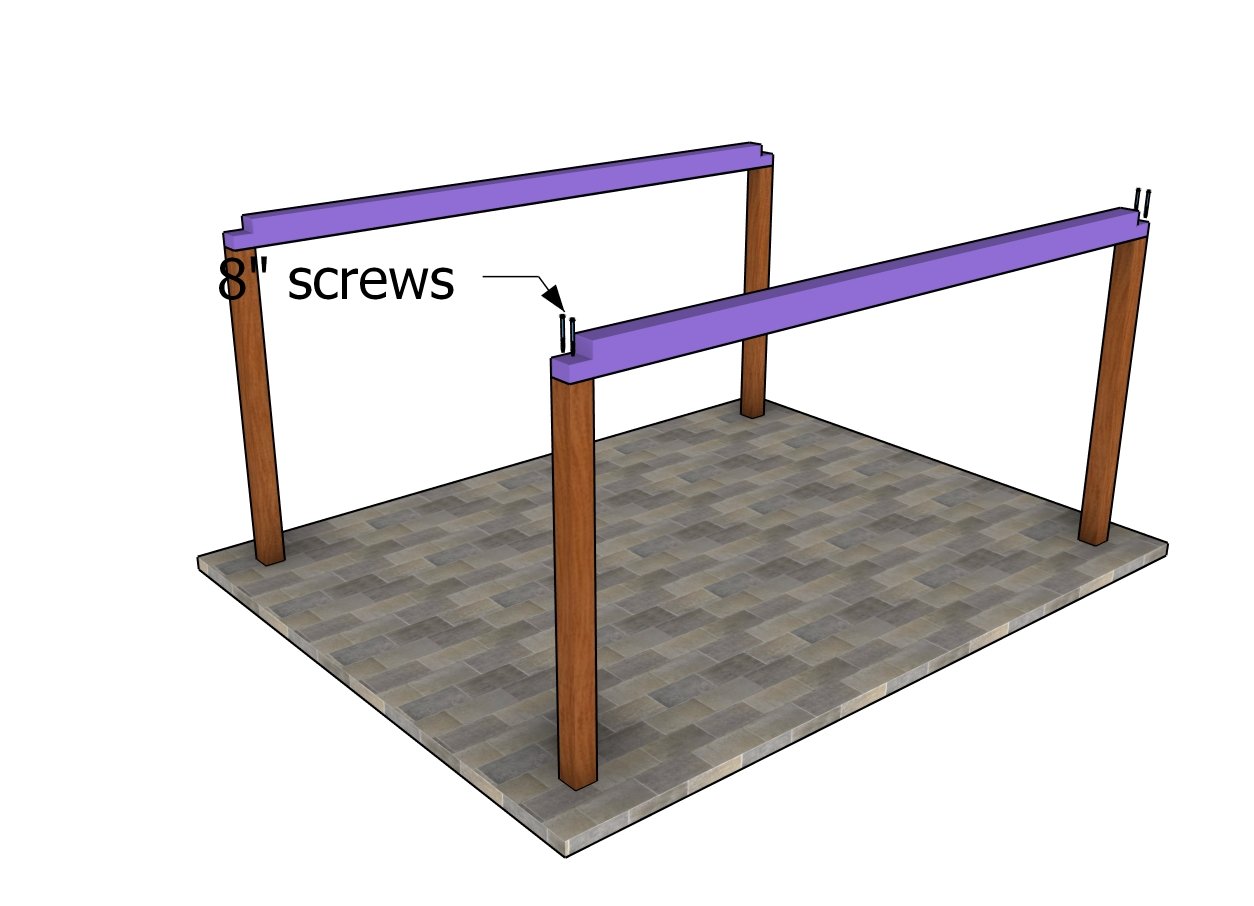
Top plates
Lift the plates to the front and back of the pavilion. Align the beams flush to both ends. Drill pilot holes and insert 8″ screws to lock them into place. Plumb the posts with a spirit level and check if the top plate is perfectly horizontal. Use 2 screws for each joint.
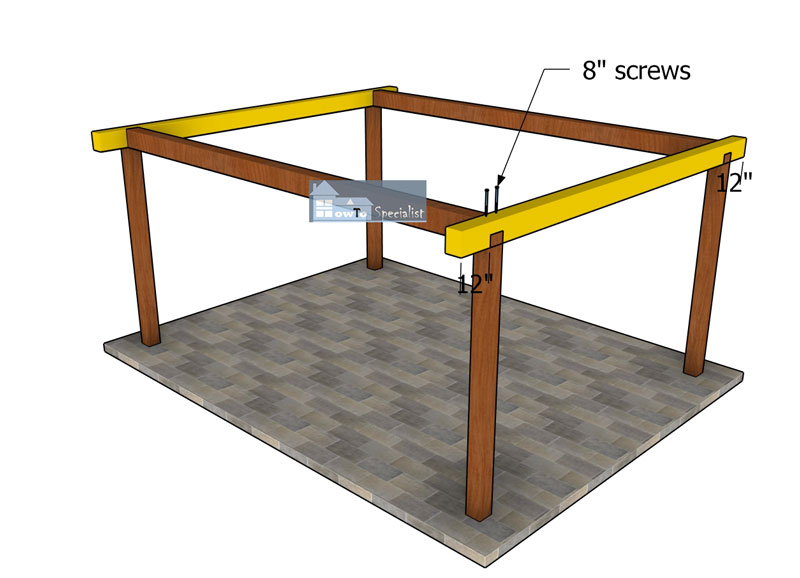
Fitting-the-side-top-plates
Fit the side top beams to the top of the pavilion. Drill pilot holes and insert 8″ screws, to assemble everything together tightly. Use a spirit level to make sure the plates are horizontal. Use a carpentry square to make sure the corners are right angled.
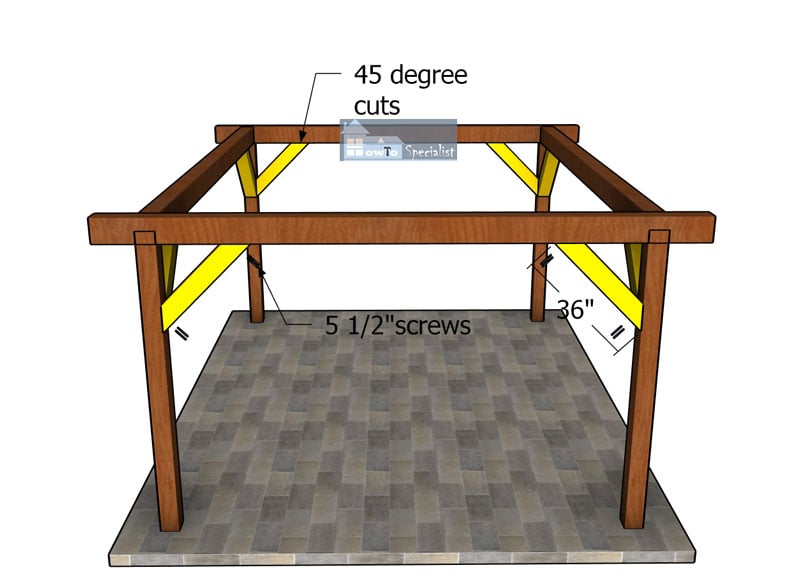
Attaching-the-braces
Cut the diagonal braces to 36″, ensuring the ends are angled to fit snugly against the posts and beams. Attach the braces securely by nailing or screwing them into the posts and beams, checking that they are level and form a solid triangle for added stability.
How to Build a Large Pavilion Roof
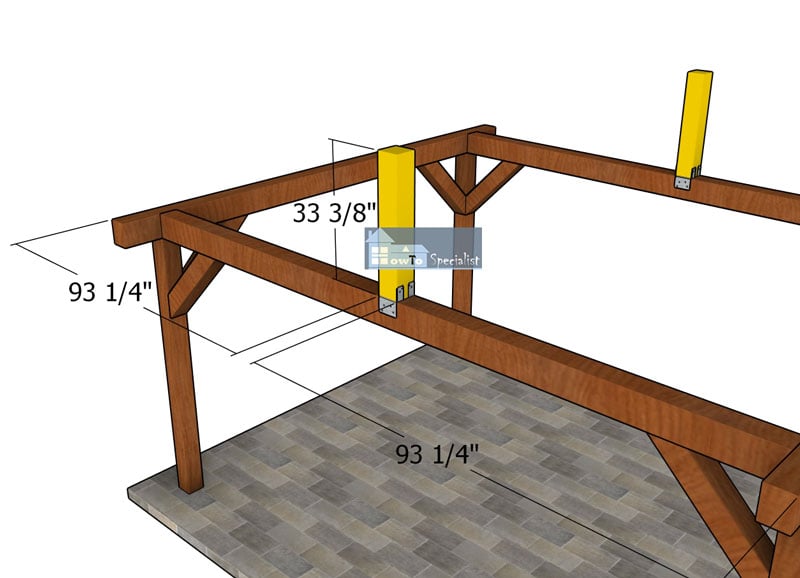
Supports-for-ridge-beam
Use 6×6 lumber for the ridge beam supports. Center the supports to the cross plates and secure them into place with 2 1/2″ structural screws and post to beam connectors. Plumb the posts with a spirit level before setting the supports into place. The supports are dimensioned for a corresponding 5:12 roof pitch.
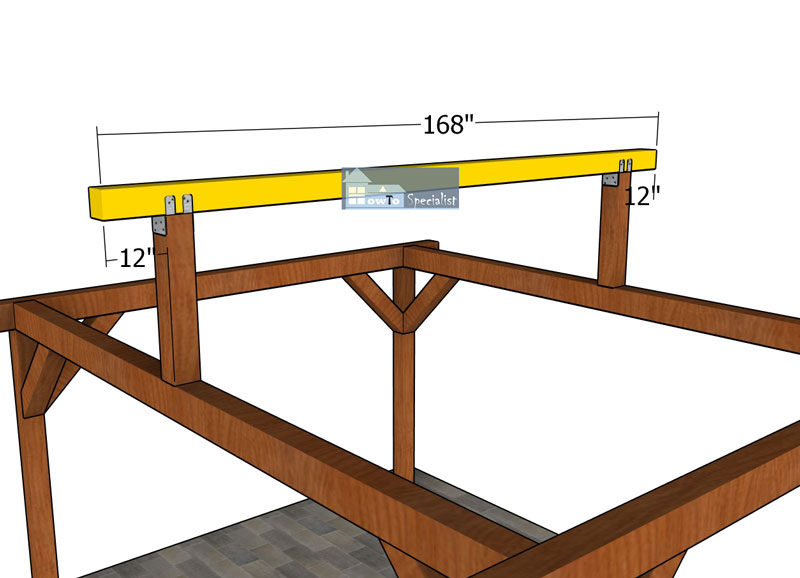
Fitting-the-ridge-beam
Use 6×6 lumber for the ridge beam. Notice the 12″ front and back overhangs. Place the ridge beam to the supports and make sure the corners are square. Use post to beam connectors and 2 1/2″ structural screws to secure the beam into place tightly.
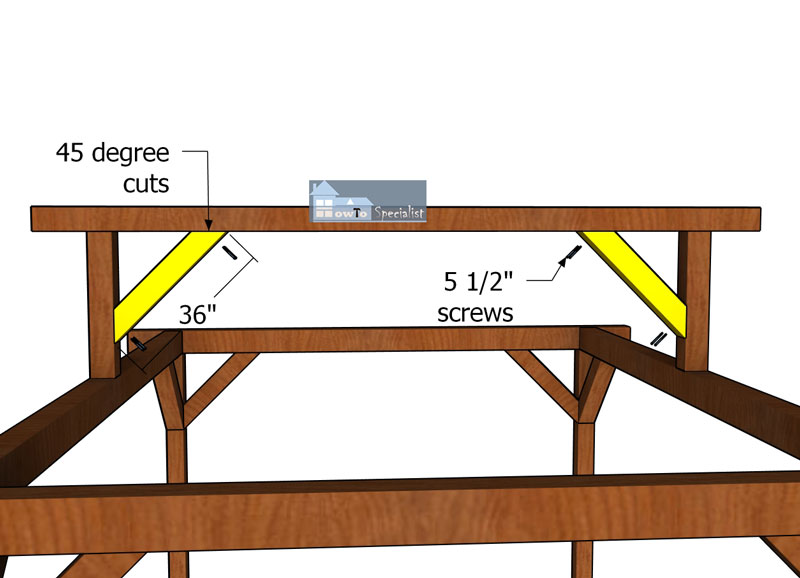
Top-braces
Fit the diagonal braces to the ridge beam. Plumb the posts, drill pilot holes through the braces and insert 5 1/2″ screws into the supports and ridge beams. Use 2 screws for each joint.
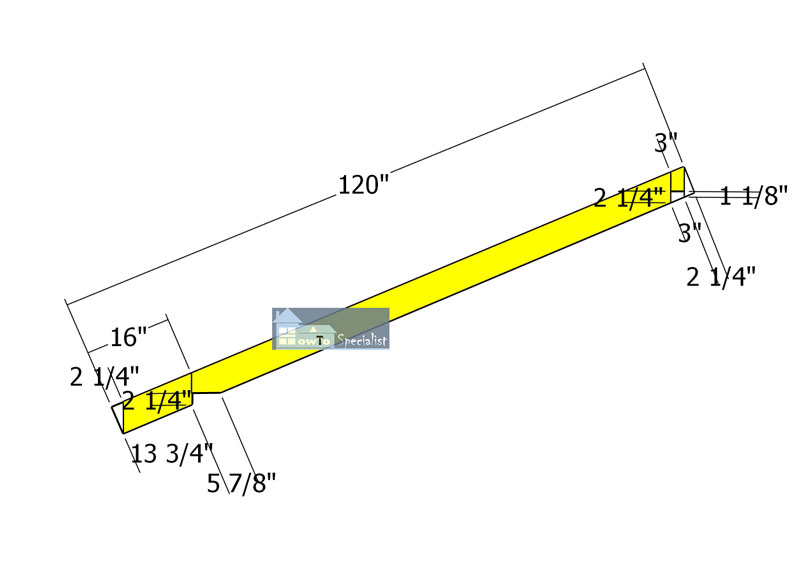
Rafters-design
Use 2×6 lumber for the rafters of the pavilion. Make 22.5 degree cuts to both ends of the rafters. The roof has a 5:12 pitch which corresponds to a 22.5 degree slope.
Measure and mark the birdsmouth cuts on the rafters, indicating the seat and heel cuts for a precise fit on the top plates. Use a saw to carefully cut along the marked lines, ensuring clean, accurate cuts for stable and secure rafter placement.
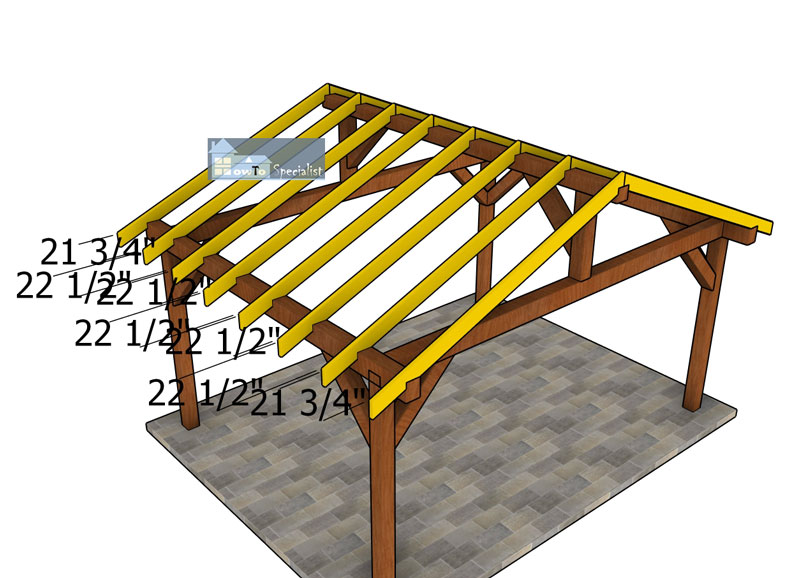
Rafters-for-16×12-pavilion
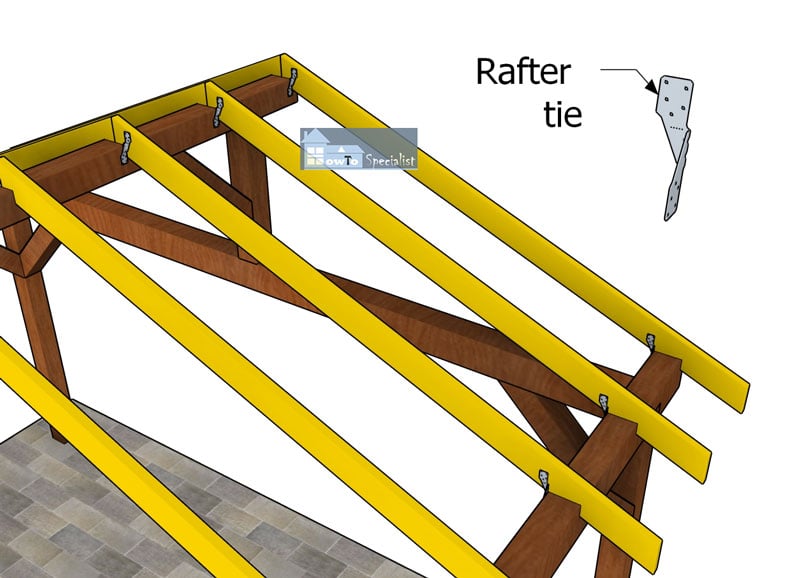
Fitting-the-rafters—16×12-pavilion
Fit the rafters to the top of the pavilion. Use the info from the diagram to space the rafters every 24″ OC (on center). The numbers you see in the plans represents the distance between the rafters. Use rafter ties and 1 1/2″ structural screws to lock the rafters into place tightly. Attach the ties to both ends of the rafters.
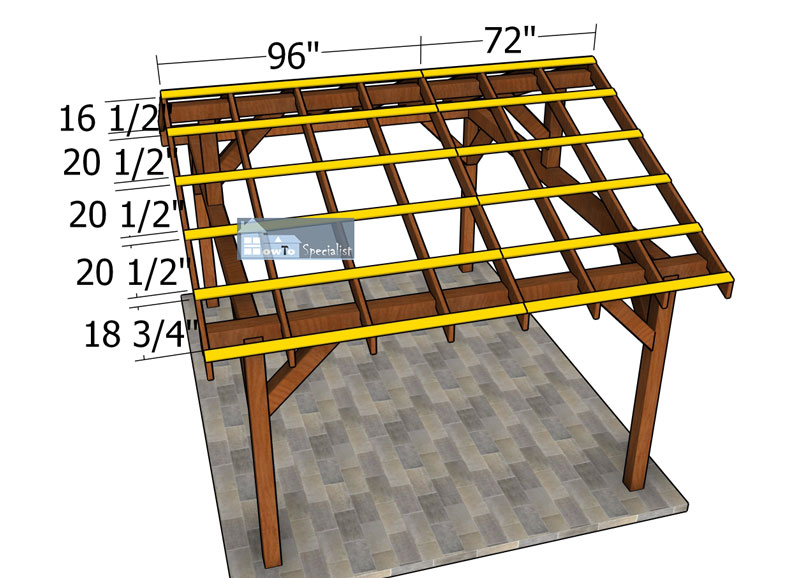
Attaching-the-purlins
This gable pavilion will be covered with metal roofing, therefore fit the 1×4 purlins for the roof structure. Place the 1×4 purlins every 24″ on center and lock them to the rafters with 2 1/2″ screws. Align the edges at both ends, before inserting the screws.
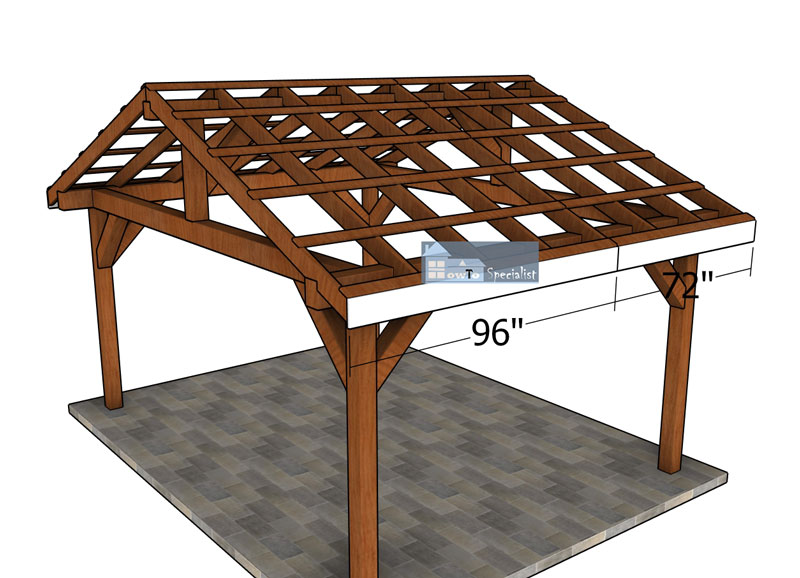
Side-roof-trims
Fit the 1×8 trims to the sides of the pavilion. Align the edges flush and insert 6d nails to lock them to the rafters.
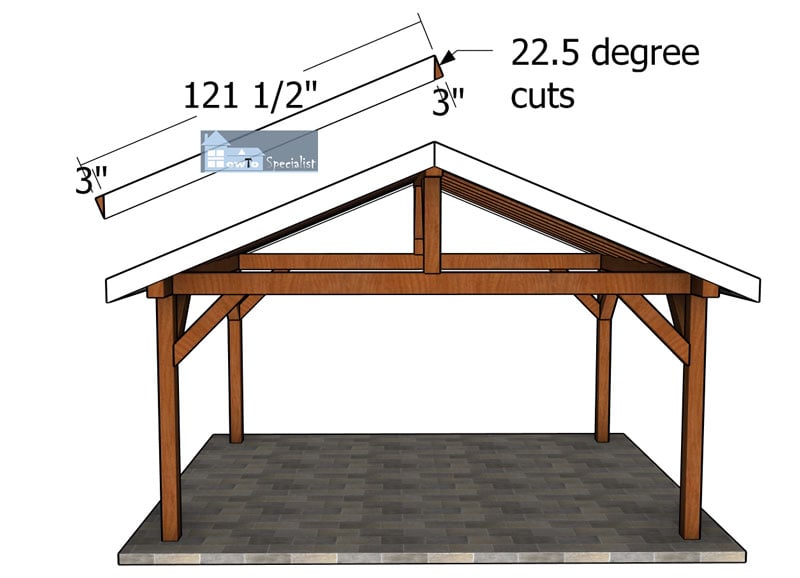
Gable-end-trims
Use 1×8 lumber for the front and back roof trims. Make 22.5 degree cuts to one end of the trims. Attach the trims to the rafters and insert 2″ / 6d nails to lock them into place tightly.
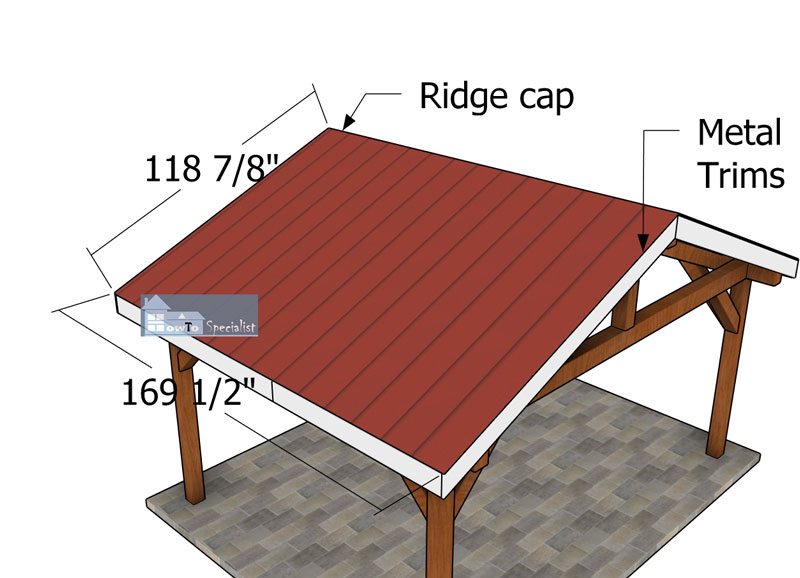
Fitting-the-roofing
Start by installing the metal roofing panels at one end of the gable pavilion, aligning the first panel with the edge of the roof and securing it with screws through the pre-drilled holes. Overlap the next panel by one ridge and fasten it in the same manner, continuing this process across the roof.
At the ridge, place a ridge cap over the meeting point of the two roof sides, securing it with screws to ensure a watertight seal. Finish by attaching metal trim along the edges and eaves to provide a clean look and extra protection against the elements.

16×12 pavilion plans – side view
Apply wood putty to any gaps, holes, or imperfections in the pavilion’s structure, ensuring a smooth and even surface. Once the putty is dry, sand the entire pavilion thoroughly, focusing on areas where putty was applied, to achieve a uniform finish.
Clean off any dust and debris from sanding before applying a primer coat of paint. Finish with two coats of high-quality exterior paint, allowing adequate drying time between coats, for a durable result.
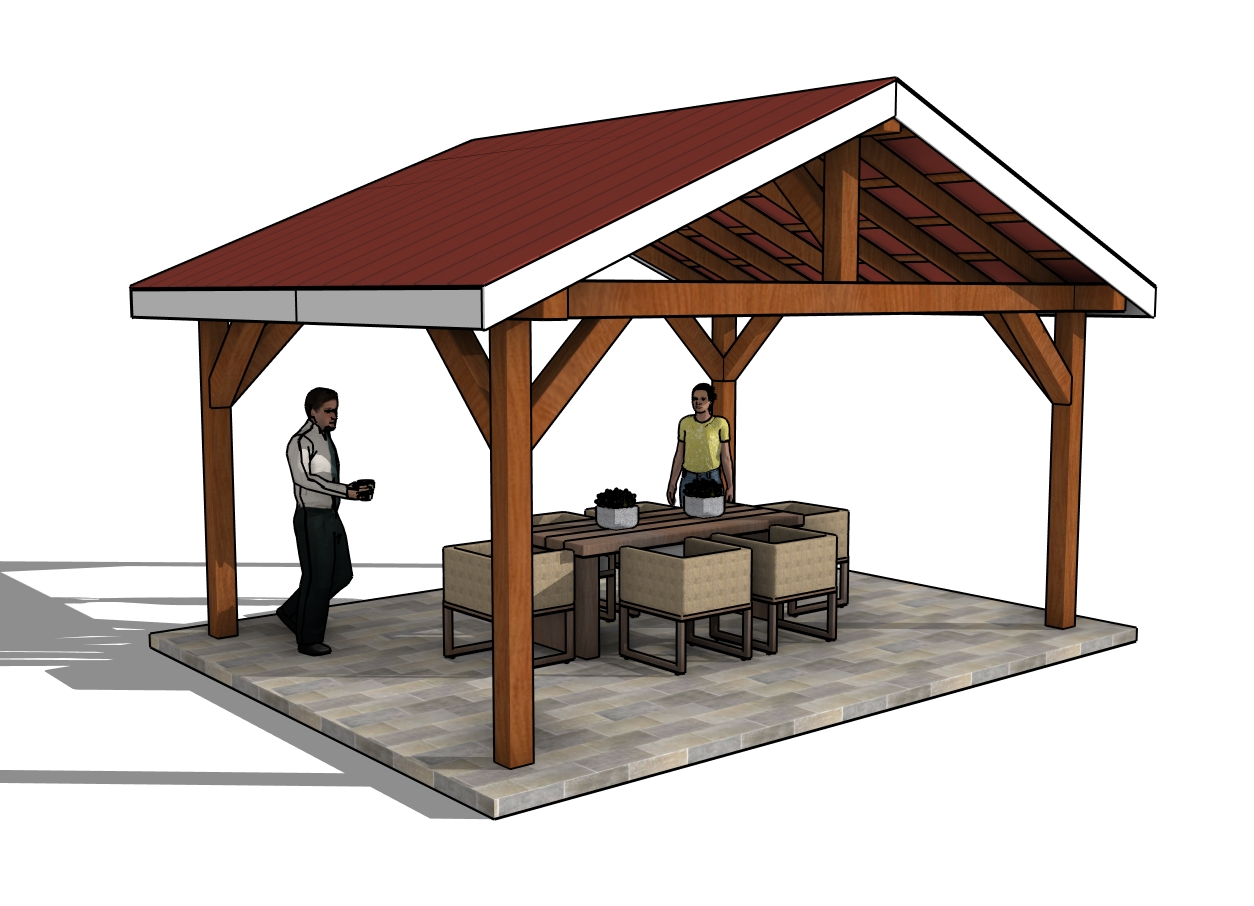
16×12 pavilion plans
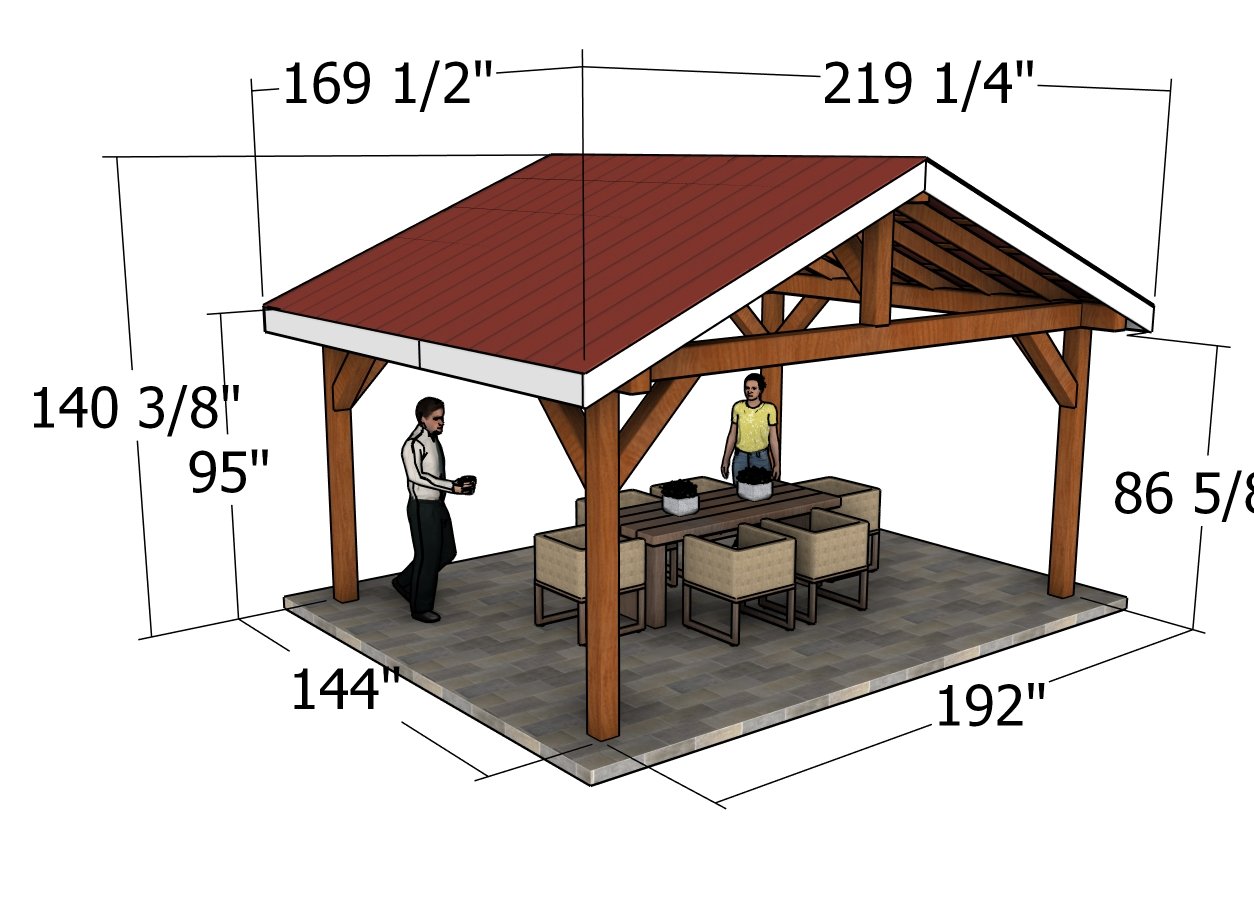
16×12 pavilion plans – dimensions
The 16×12 pavilion measures 16 feet in length and 12 feet in width, providing a spacious area suitable for various outdoor activities. Its generous dimensions allow for ample seating, dining, or recreational space, making it an ideal addition to any backyard or garden.
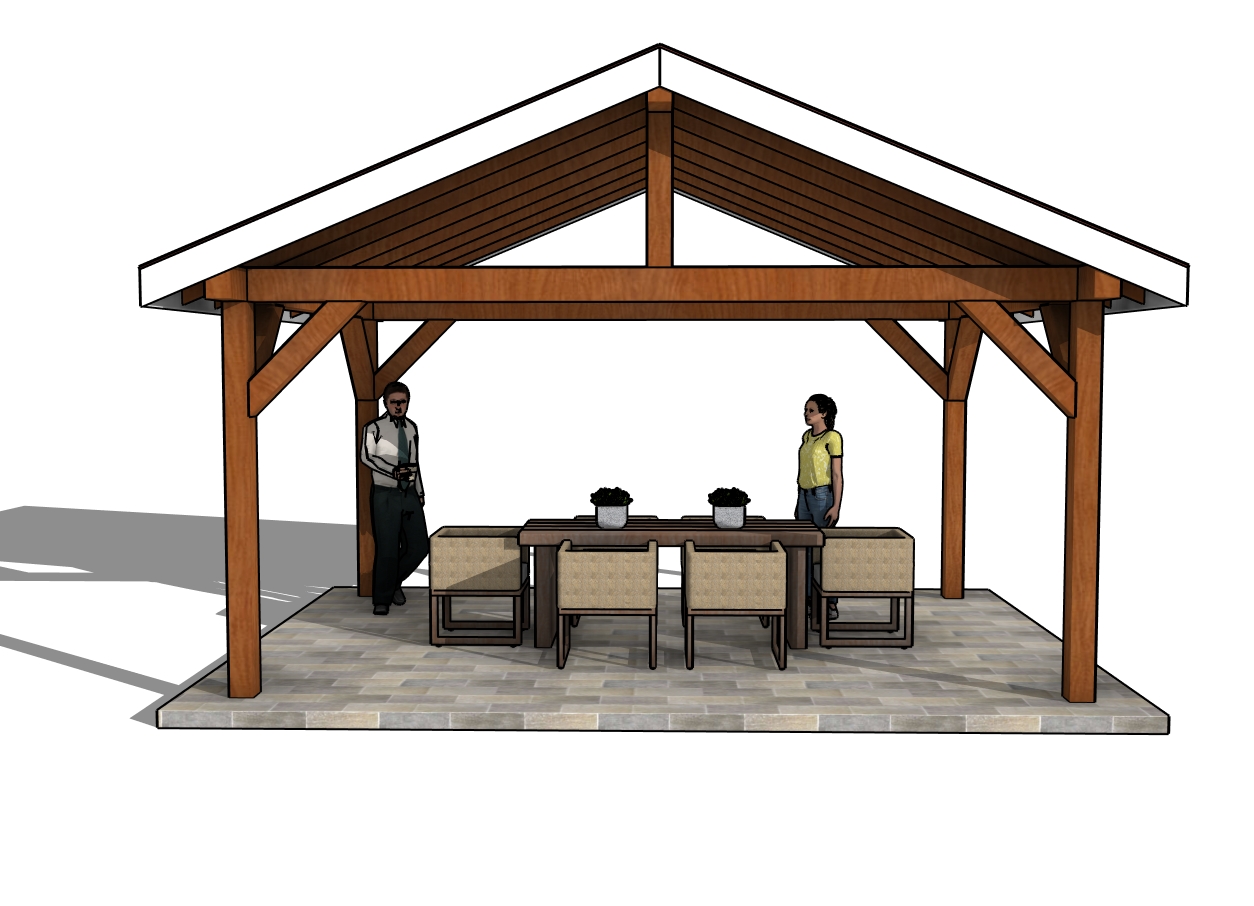
16×12 pavilion plans – front view
Building a 16×12 gable pavilion involves careful planning and precise woodworking techniques. By ensuring accurate cuts and secure fittings for posts, braces, and roofing, and finishing with putty, sanding, and paint, you create a durable and aesthetically pleasing backyard structure.
This pavilion project, with its detailed steps, results in a functional and attractive addition to any backyard or garden. If you want to download the plans. just click on the GET PDF PLANS button bellow.
Thank you for reading my project about 16×12 gable pavilion plans and we recommend you to check out the rest of the projects. Don’t forget to LIKE and SHARE our projects with your friends, by using the social media widgets. SUBSCRIBE to be the first that gets our latest projects.

